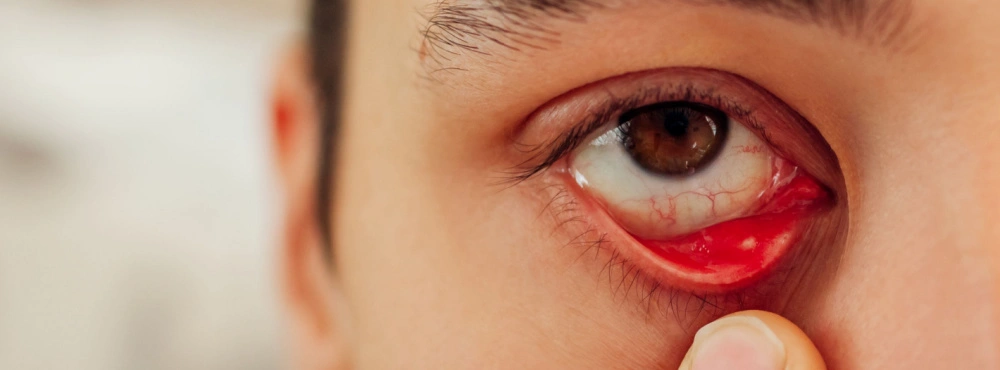Giant Papillary Conjunctivitis (GPC) is an allergic reaction that causes the inside of your upper eyelids to become inflamed, irritated and swollen. This type of allergic conjunctivitis causes hypersensitivity and other uncomfortable symptoms, this article details the cause and treatments for GPC.
What is giant papillary conjunctivitis?
This condition causes giant papillae to form on the inside of the eyelids, this can only be seen when you lift the eyelid up to see inside. If you wear soft contact lenses, you are more likely to develop this condition compared to those that wear rigid gas permeable lenses.
What causes GPC?
Contact lens induced papillary conjunctivitis is mostly caused by contact lenses, but it can also be caused by other foreign bodies such as exposed stitches and ocular prostheses. The condition results from a foreign body rubbing against the upper tarsal conjunctiva (upper inside of the eyelid). Those with meibomian gland dysfunction may also be more likely to develop this condition. This condition can also develop as an allergic response to contact lenses, pollen or other allergies.
What are the symptoms of giant papillary conjunctivitis?
Symptoms you may experience with this condition include eyes that are:
- Itchy
- Irritated
- Swollen
- Red
- Filled with mucus
People who wear contact lenses are often advised to switch to prescription glasses whilst they are experiencing symptoms. If you are still able to tolerate contact lenses, you may have blurry vision and/or feel like the lens is moving around the eye a lot. You may also feel like there is something in your eye. It is best to stop wearing lenses until the condition has been fully treated.
How is GPC diagnosed?
Your conjunctiva/cornea will be examined using a slit lamp biomicroscope. Fluorescein (an orange dye) may be used to allow the practitioner to see any papules (skin lesions) that may have formed on the inside of your eyelids.
Typically, you should visit your optician every two years for an eye test and every year for a contact lens check-up (unless a healthcare professional has advised that you visit an optician more frequently). If you ever experience discomfort with your eyes, you should book a visit with your optician, even if you aren’t due for an appointment yet.
How is GPC treated?
Giant papillary conjunctivitis should be treated quickly as leaving this condition untreated can result in serious damage to the eyelid and/or the cornea which can then lead to sight loss. You should stop wearing contact lenses for a few weeks, or at least until the condition is under control. Switching to daily disposables may be advised, particularly for mild cases of the condition.
Adhering to your lens replacement schedule, maintaining good hygiene and/or removing the physical irritant (such as stiches) usually allows this condition to resolve itself. Further treatment options aren’t usually needed, sometimes eye drops or a topical cream might be prescribed to help with inflammation.
Can I avoid developing giant papillary conjunctivitis?
Contact lens wearers who replace their contact lenses more frequently (every day or every 2 weeks) have a lower chance of developing GPC compared to those who replaced their lenses every month or longer.
- Don’t wear contact lenses whilst asleep
- Avoid any build-up of deposits on your lenses
- Always adhere to your lens-cleaning routine (unless you wear daily disposables, which do not require cleaning)
- Don’t exceed the recommended wearing time for your lenses
Disclaimer: The advice in this article is for informational purposes only and does not replace medical care or an in-person check-up. Please check with an eyecare professional before purchasing any products or remedies. For information on our article review process, please refer to our Editorial Policy.

 Offers
Offers Account
Account
 Favorite
Favorite
 Basket
Basket

 OFFERS
OFFERS
















